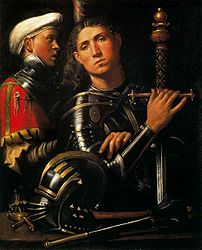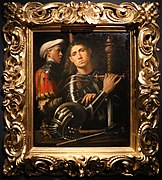Category:Portrait of Warrior with his Equerry (Uffizi Gallery)
| Portrait of Warrior with his Equerry (Uffizi Gallery) | ||||||||||||||||||||||||||||||||||||||||||||||||||||||||||||||||||||||||||||||||||||||||||||||||||||
|---|---|---|---|---|---|---|---|---|---|---|---|---|---|---|---|---|---|---|---|---|---|---|---|---|---|---|---|---|---|---|---|---|---|---|---|---|---|---|---|---|---|---|---|---|---|---|---|---|---|---|---|---|---|---|---|---|---|---|---|---|---|---|---|---|---|---|---|---|---|---|---|---|---|---|---|---|---|---|---|---|---|---|---|---|---|---|---|---|---|---|---|---|---|---|---|---|---|---|---|---|
| ||||||||||||||||||||||||||||||||||||||||||||||||||||||||||||||||||||||||||||||||||||||||||||||||||||
painting by Giorgione | |||||
| Upload media | |||||
| Instance of | |||||
|---|---|---|---|---|---|
| Depicts | warrior, squire, sword, helmet, Morning star (weapon), parapet, gorget and lance | ||||
| Made from material | |||||
| Genre |
| ||||
| Location | Uffizi Gallery, borough 1, Florence, Metropolitan City of Florence, Tuscany, Italy | ||||
| Creator | |||||
| Collection | |||||
| Inventory number |
| ||||
| Inception |
| ||||
| Width |
| ||||
| Height |
| ||||
| |||||
Italiano: L'opera pervenne in galleria nell'aprile 1821 dalla Galleria Imperiale diVienna, a seguito di un normale scambio di quadri, con l'attribuzione a Giorgione, attribuzione che compare gia' nell'inventario del 1825. La critica successiva ritiene invece che sia un'opera probabilmente derivata da un dipinto perduto di Giorgione, forse ad opera di Paolo Morando il Cavazzola.
English: The work came to the gallery in April 1821 from the Imperial Gallery in Vienna, following a normal exchange of paintings, with the attribution to Giorgione, an attribution that already appears in the inventory of 1825. Later critics believe that it is a work probably derived from a lost painting by Giorgione, perhaps by Paolo Morando il Cavazzola.
Media in category "Portrait of Warrior with his Equerry (Uffizi Gallery)"
The following 9 files are in this category, out of 9 total.
-
Cavazzola Guerrero con su escudero 1518-22 Uffizi.jpg 806 × 1,010; 95 KB
-
Giorgione (attr.), ritratto di scudiero detto il gattamelata, 1505-10 ca. 01.jpg 2,472 × 2,772; 4.97 MB
-
Giorgione (attr.), ritratto di scudiero detto il gattamelata, 1505-10 ca. 02.jpg 2,358 × 2,742; 2.86 MB
-
Giorgione, Portrait of Warrior with his Equerry.jpg 646 × 800; 105 KB
-
The “Gattamelata”, portrait of man in armour with a squire (by Giorgione) - Uffizi.jpg 1,531 × 1,920; 1.16 MB
















